Overview
Within This Page
Article III of the Constitution establishes the Judiciary as one of the three independent branches of the Federal government, and provides for a Supreme Court and whatever other federal courts Congress considers necessary. Since the Federal Court system was first defined by Congress in 1789, Congress has divided the country into 94 federal judicial districts, each with its own U.S. District Court (USDC). The USDCs are the federal trial courts, where cases are tried, witnesses testify, and juries serve. Even as the system evolved, the number of federal judges remains relatively small. There are currently about 677 authorized USDC judgeships, and approximately 1,200 senior district, magistrate, and bankruptcy judges. Most districts have more than one facility where court is held. Typically, one to five judges are located in small- to medium-sized court facilities; however, in several large metropolitan areas, as many as 50 to 75 judges are located in a single facility. Generally, one trial courtroom is required for each district judgeship.
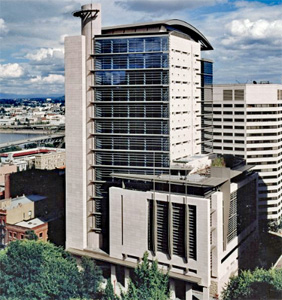
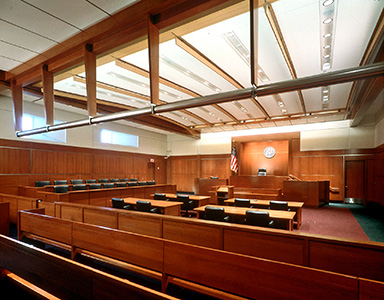
Left: The exterior of the Mark O. Hatfield U.S. Courthouse in, Portland, Oregon, has a distinctive cantilevered roof that shelters a small green planting area visible to traffic approaching on Washington Street. Designed with energy efficiency in mind, the building exceeded Oregon's Energy Code by 29 percent when it was built. Right: Fine detailing and woodwork in one of the building's courtrooms.
Photo Credits: Kohn Pedersen Fox Associates, BOORA Architects, GSA
Congress has grouped the 94 USDCs into 12 regional circuits, and established within each circuit a single U.S. Court of Appeals (USCA); there is also a Federal Circuit court with limited jurisdiction in Washington, DC. Litigants who lose in the USDC may appeal their case to the USCA, which reviews cases usually in panels of three judges and without juries, to see whether the trial judge applied the law correctly. The USCA is the final stop for most litigation in the federal system. There are currently about 170 USCA judges authorized for the 12 regional circuits. Most circuit courts hold court only in one or two cities within the circuit, although circuit judges might have offices elsewhere in the circuit. Therefore, most federal court facilities do not contain USCA judges or courtrooms.
As the preeminent symbol of federal authority in local communities, a federal courthouse must express solemnity, stability, integrity, rigor, and fairness. The U.S. General Services Administration (GSA), which is part of the Executive Branch, is the federal agency responsible for federal court design, construction, and maintenance. The need for major renovation or new courthouse construction is identified by the Judicial Conference of the United States in a five-year plan of requirements, updated and approved each year. The Administrative Office of the U.S. Courts (AOUSC) serves as staff to the Federal judiciary. Located in Washington D.C., the AOUSC performs a wide range of administrative duties to assist the operation of the federal courts, and is the primary liaison with GSA and the U.S. Marshals Service, a unit of the Executive branch, which provides judicial security.
Building Attributes
In addition to the traditional life-safety and health concerns common to all buildings, federal courthouse facilities must adhere to guidelines for their aesthetics, security, sustainability, adjacency and circulation, barrier-free access, mechanical/electrical systems, automation, acoustics, interior finishes, and signage.
A. Types of Spaces
Courtroom Spaces
Public Courtroom Support Spaces
- Convenience Store, Kiosk, or Vending Machines
- Bookstore
- Lobby: Central location for building directory, schedules, and general information
- Common Space: Informal, multi-purpose recreation and social gathering space
- Cafeteria or Dining Hall
- Restrooms
Restricted/Secure Courtroom Support Spaces
- Judicial Chamber: Includes judge's offices and circulation
- Enhanced Office: Includes ancillary offices, jury facilities, and other spaces attached to courtrooms such as the Judge's Conference Room, Judge's Robing Room, News Media Room, Service Unit, Private Toilet, and Equipment Storage
- Detention Cell: Maximum security spaces controlled by the USMS
Administrative Support Spaces
- Administrative Offices: May be private or semi-private acoustically and/or visually.
Operation and Maintenance Spaces
- General Storage: For items such as stationery, equipment, and instructional materials.
- Food Preparation Area or Kitchen
- Computer/Information Technology (IT) Closets or data processing areas. See WBDG Automated Data Processing: PC System for related information.
- Maintenance Closets
B. Important Design Considerations
Typical features of Federal Courthouse buildings include the list of applicable design objectives elements as outlined below. For a complete list and definitions of the design objectives within the context of whole building design, click on the titles below.
Accessible
Conform to the barrier-free standards set forth in the Americans with Disabilities Act Accessibility Guidelines (ADAAG).
- All public areas in federal court facilities must be accessible when newly constructed or renovated.
- Within the courtroom, the witness stand, jury box, and well of the court must be accessible, and the judge's bench and clerk's station must be adaptable when newly constructed or renovated.
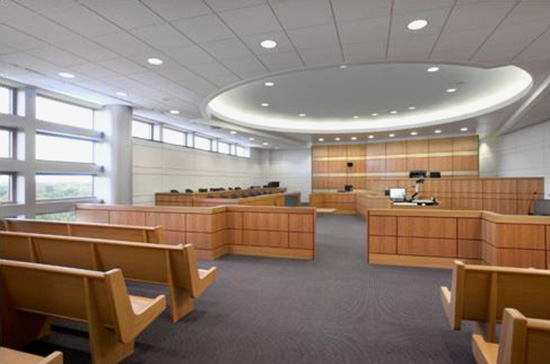
The main aisle in a courtroom of adequate width that also includes a rail without a gate for ease of access.
Photo Credit: U.S. Access Board
Aesthetics
Reflect the dignity, enterprise, vigor, and stability of the federal government in accordance with the Guiding Principles for Federal Architecture.
- To this end, a courthouse must express solemnity, stability, integrity, rigor, and fairness of the American judicial process.
- The facility must also contribute positively to the architectural fabric of the local community.
Interior Finishes
- Finish with durable materials that reflect the dignity of the judicial system and the seriousness of judicial proceedings.
- The interior architecture of public spaces in the courthouse should exhibit this dignity and seriousness.
Cost-Effective
- Incorporate a limited palette of durable materials and finishes that respond to construction cost limitations, optimize life-cycle performance, and satisfy functional requirements for each project.
- Optimize the building for the long-term by conducting a life-cycle cost analysis, and performing sustainable operations and maintenance practices and commissioning.
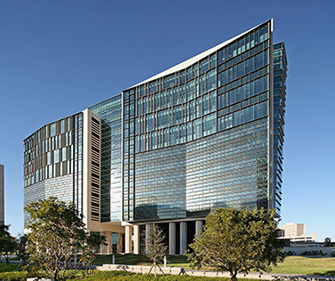

The 578,000 SF Wilkie D. Ferguson, Jr. U.S. Courthouse is a state-of-the-art, efficient, and cost-effective facility in Miami, Florida, designed by Arquitectonica in consultation with HOK. The courthouse reflects the dignity of the judicial process, provides stringent security, meets the requirements of the U.S. Courts Design Guide, and the needs of the GSA and citizens of Miami. The structure consists of two towers connected by a curved glass prism. Each tower has 14 floors and the glass prism contains the waiting rooms and circulation spaces.
Photo Credits: Arquitectonica
Functional / Operational
Acoustics
Provide for speech intelligibility and privacy.
- Speech intelligibility is a measure of the ability of a listener in the room to understand what is being said. Privacy is the measure of limiting speech intelligibility to the intended listener. Spaces in a courthouse are designed to provide one of four levels of acoustical privacy: inaudible, confidential, normal, and minimal.
Automation
Anticipate court reporting and court computer services and be adaptable to change as automation technology evolves.
- The federal judiciary is committed to automating various court functions, concentrating on the following: automated data-processing system servers, electronic evidence display in the courtroom, courtroom-based personal computers, data communications networks, and satellite video broadcasts.
Signage
Direct users clearly and efficiently to desired destinations.
- Signs significantly impact the functional and aesthetic quality of a court facility. The specific strategy for a building's signs must be determined early in the facility design process.

The interior and exterior signage program of the Lloyd D. George U.S. Courthouse in Las Vegas, Nevada was designed using stainless steel as the primary material to reflect the architecture. The exterior signage consists of freestanding pylons for project identification and wayfinding from the surface parking area to the building. The pedestrian entrances are identified with cast bronze, nickel plated, prismatic letters pin mounted to the adjacent granite walls.
Photo Credits: Cannon Design
Historic Preservation
There are many historic federal courthouses in the U.S. and the opportunities and resources to preserve these special places are available to support that process. It is also possible to update them to meet current accessibility, security, technology, and sustainability standards while preserving the historic character and features. Particular maintenance practices for historic structures should be incorporated to properly maintain cultural resources and building elements.
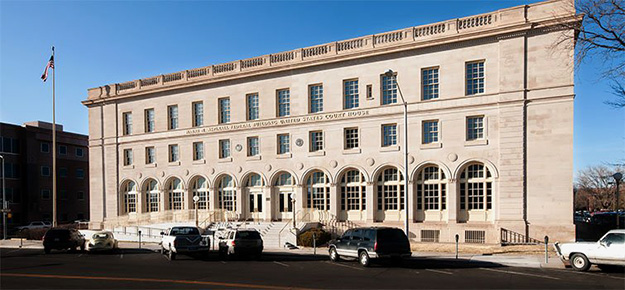
The U.S. General Services Administration made the decision to align historic preservation renovations with zero energy goals in the Wayne N. Aspinall Federal Building and U.S. Courthouse in Grand Junction, Colorado.
Photo Credit: Energy.gov
Secure / Safe
Plan with safety and security as integral and crucial design considerations which include physical and information security.
- Security planning must be factored in at the beginning of the design process and carefully integrated with other building system controls, such as fire-safety and HVAC. Conduct a threat, vulnerability assessment and risk analysis as part of the planning process to deteremine the required strategies necessary.
- Courthouse security is complex, in that court components and circulation patterns require varying degrees of security.
- Optimal courthouse security is a fine balance between architectural solutions; allocation of security personnel; and installation of security systems and equipment.
- Conduct an effective site security analysis to determine appropriate site and building strategies.
- Utilize CPTED principles to proactively design security into the project without compromising aesthetics, but that also provide cost savings, improved quality of life for building users, and decreased loss and liability.
Adjacency and Circulation
Define three separate circulation zones for public, restricted, and secure movement.
- Public circulation requires a single controlled entry, but allows free movement within the public areas of the building.
- Restricted circulation has a controlled interior entry and is limited to judges, court personnel, and official visitors.
- Secure circulation is intended for prisoners and is controlled by the U.S. Marshals Service (USMS).
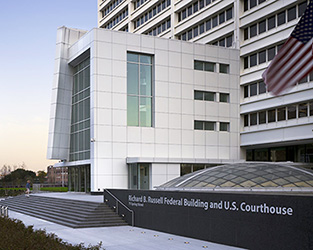
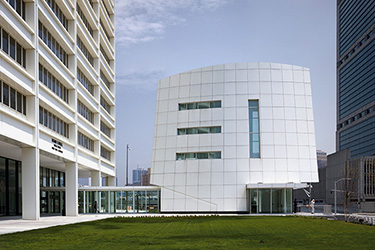
The entry security screening Pavilion at the Richard B. Russell Federal Building and U.S. Courthouse in Atlanta, Georgia, was part of an update to the 1960s facility that also included completely refurbishing the district courtrooms, and their waiting areas and elevator lobbies. The Pavilion is spacious, open, and inviting, but provides resistance to possible security threats.
Image Credits: CGL
Sustainable
Site Selection
- Consider previously developed sites or brownfield sites for the development of a new federal courthouse building to reduce the impact on land use and natural habitats. Also, consider existing buildings that can be retrofitted to reduce the use of resources needed to create a new building while also minimizing the disturbance of new sites.
Mechanical/Electrical Systems
Possess flexible, multi-zoned mechanical equipment with state-of-the-art controls and energy efficiency features.
- All court and judiciary-related offices must have individual HVAC controls, monitored from a central location.
- To control noise during all modes of operation, the systems must be provided with one or more of the following: sound traps and acoustical lining in duct work, low-velocity, low-static-pressure fan systems, and/or special low-noise diffusers.
- Electrical design should anticipate future requirements for video and audio systems; electric data processing, retrieval, and display; electronic security systems; and new generations of sophisticated office equipment.
Materials and Furnishings
- Building materials and resources should be durable and sustainable to reduce environmental impacts, long-term operations and maintenance costs, and promote indoor environmental quality.
Water Efficiency
- Incorporate water saving fixtures and equipment to protect and conserve water. Also plan for landscaping that requires little to no water use. Recover non-sewage and graywater for on-site use (such as toilet flushing and landscape irrigation, and more generally, consider the water quality requirements of each water use).
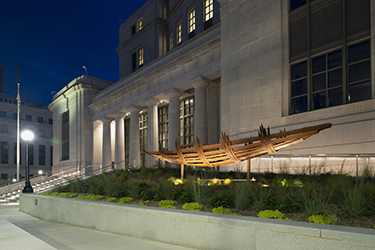
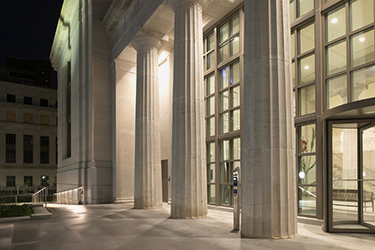
The U.S. Federal Courthouse project in Mobile, Alabama, will meet the long-term needs of the U.S. Courts there and consolidate court operations out of leased space into a secure, high-performing, federally-owned campus. A new 155,600 SF courthouse with 6 courtrooms and 9 chambers will feature a limestone facade sourced from Russellville, Alabama. Renovations to the existing Campbell Courthouse are designed to improve security and accessibility, provide upgrades to energy-efficient building systems, enhance life safety features (including the installation of a new fire suppression system), abate hazardous materials, and improve tenant and public spaces. Energy Star-rated equipment, high efficiency lighting, water conserving plumbing, solar-powered water heating systems, and low-emitting materials will be utilized in the facility. The sustainable design is projected to meet LEED Gold certification.
Photo Credits: Hartman-Cox Architects
C. Example Design and Construction Criteria
For GSA, the unit costs for this building type are based on the construction quality and design features found in GSA Unit Cost Study - Shell & Core: Courthouse table . This information is based on GSA's benchmark interpretation and could be different for other owners.
Emerging Issues
The federal judicial system has experienced facilities-related challenges caused by heightened and changing security needs (such as bio-terrorism); automation of legal processes (especially increasing reliance on electronically filed records and the use of automation in the courtroom); and significant caseload increases. Thus, the need for flexibility and innovation in designs to meet these challenges now and in the future are critical design considerations. Successful courthouse design requires defining and addressing these issues, and integrating all the necessary disciplines to address them throughout the design and construction process.
Relevant Codes and Standards
The single most targeted resource for the planning and design of federal court facilities is the U.S. Courts Design Guide, revised in March 2021. The Guide was developed in a cooperative effort between the Federal judiciary and a team of experts in space planning, security, acoustics, mechanical/electrical systems, and automation. The U.S. Courts Design Guide complements the GSA facilities standards handbooks. It serves as a planning tool for federal judges and other personnel involved in the design of a federal court facility and provides relevant information for the General Services Administration (GSA) and an architecture/engineering (A/E) team to plan, program, and design a functional, aesthetically-appropriate, sustainable, safe, accessible, and cost-effective court facility.
Additional Resources
Publications
- Architectural Graphic Standards, 12th Edition, by The American Institute of Architects, Dennis J. Hall, Editor-in-Chief. New York, NY: John Wiley & Sons, Inc., 2016.
- Building Type Basics for Justice Facilities by Todd S. Phillips, Michael A. Griebel. New York, NY: John Wiley & Sons, Inc., July 2003.
- Courtroom Lighting—Criteria Evaluation and Energy Use Study, GSA
- Green Courthouse Design Concepts, GSA
- Guiding Principles for Sustainable Federal Buildings by the Council on Environmental Quality, December 2020.
- Justice for All: Designing Accessible Courthouses, Recommendations from the Courthouse Access Advisory Committee , U.S. Access Board
- Mechanical Lift Analysis—Accessibility Method for Accommodation of Physically Disabled People in the U.S. Courthouse Courtrooms, GSA
- PBS-P100 Facilities Standards for the Public Buildings Service, GSA
- Standard Level Features and Finishes for U.S. Courts Facilities, GSA
- Sustainable Justice 2040: Green Guide to Justice, by The AIA Academy of Architecture for Justice. Washington, DC: The American Institute of Architects, 2020.
- U.S. Courts Design Guide by the Judicial Conference of the United States. March 2021.
Others
- Administrative Office of the U.S. Courts (AOUSC)
- Academy of Architecture for Justice (AAJ)—a Knowledge Community of The American Institute of Architects which promotes and fosters the exchange of information and knowledge between members, professional organizations, and the public for high-quality planning, design, and delivery of justice architecture.
- Building Research Information Knowledgebase (BRIK): Judicial Facilities—an interactive portal offering online access to peer-reviewed research projects and case studies in all facets of building, from predesign, design, and construction through occupancy and reuse.
- GSA's Courthouse Program—ensures the consistent, excellent, and cost-effective delivery of the courthouse construction program.
- Historic Preservation Policy, Tools & Resources—GSA learns and innovates while preserving America's cultural heritage. The Center for Historic Buildings collects, refines, and maintains this knowledge through these resource links.
- U.S. Marshals Service, Judicial Security Division—provides a variety of programs to anticipate and increase the security of the federal judiciary, including threat assessment, funding and education programs.








